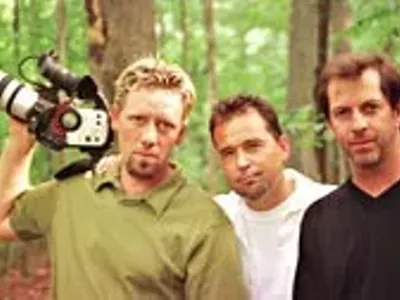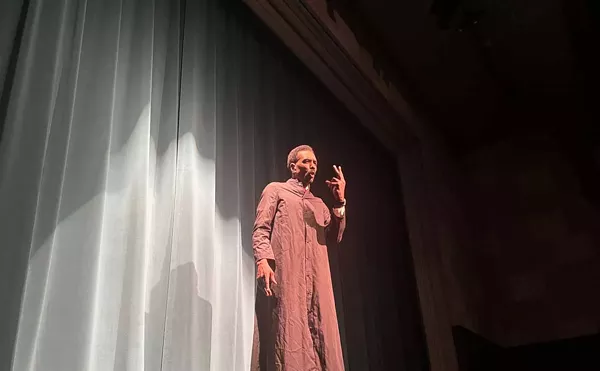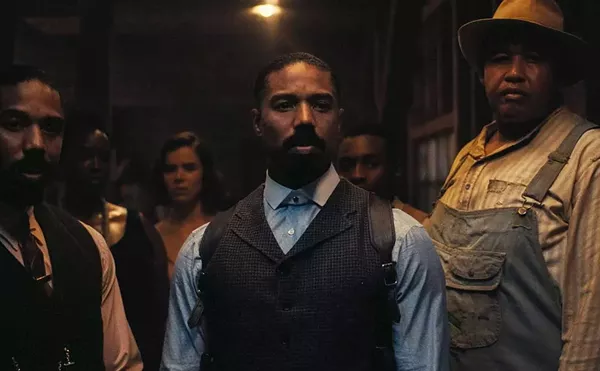
Audio By Carbonatix
[
{
"name": "GPT - Leaderboard - Inline - Content",
"component": "35519556",
"insertPoint": "5th",
"startingPoint": "3",
"requiredCountToDisplay": "3",
"maxInsertions": 100,
"adList": [
{
"adPreset": "LeaderboardInline"
}
]
}
]
Ronald Warunek is one of those visionary artists you only read about and never see until they’re enshrined in some horrible art history book that tries to tell you what really happened. From your first encounter with his simple pastel, pop-artistic landscapes, you sense a fundamental experience of the world that transports you into the rare genre of spiritual allegory.
While passionately devoted to his mission, Warunek speaks with a friendly (but driven) quality that’s quite attractive. He has none of that “frustrated artist” syndrome, but more of the proselytizing preacher about him, perhaps because he has a mission that engages the world on many fronts.
In his writings (an uncommon project for most artists), published both on his Web site and in at least one prestigious art-and-science journal, Warunek speaks about the technologies of art production, the psychology of perception and the social circumstances of art. In short, he’s unusually attentive to the many implications of art making. At the same time, his work has a decidedly non-mainstream, beneath-the-critical-radar quality that could be mistaken for eccentric — or even mad-hatter — though his artistic output is no doubt cutting-edge.
Of the three basic components of Warunek’s artistic oeuvre, the oil paintings at first seem a little too sweet, but with scrutiny become powerful evocations of his allegorical vision. In one painting, a pink poplar-like tree points its tall paintbrush toward a green sky. It’s a very modest image that packs a poignant wallop.
Within the almost disturbing pastel palette of the oil paintings there’s a hallucinatory quality that might remind one of idealized versions of spring, but which is much more emancipating than mere representations of seasonal rebirth. Warunek playfully says of the pink trees that, “the reason I make trees pink is because God didn’t. He would’ve been much better off with pink trees. I think he must have had some investment in green.”
Actually Warunek is actively involved in his church and fervently believes that “all good things come from God.” As he speaks, one sees that the relationship between his faith and making art involves investigating the world and transforming it into a better place. The basic pretext of his work is about using art as both a metaphoric tool of transformation as well as an actual instrument of change.
“I really painted the oils because I wanted to make something pleasant,” he says as if to give a viewer a special spin on the visual world, and not necessarily as the best explanation of his mission. The subjects of the oils vary but there’s a prevalence of Edenic landscapes, while many of his other images have an apocalyptic darkness that’s the result of his experimentation with materials.
Near the window of his Detroit studio, overlooking Gratiot Avenue, there are a few black, vertical-standing rectangular boxes, about as tall as a human being. At the top of each is a television-like screen. One contains an image of a swirling-yellow sunburst vortex with an urban landscape in the distance. The other has an almost Blakean apocalyptic image of female nudes and skulls in a visionary landscape (pictured). Both works are typical of Warunek’s convincing biblical iconography, and their light source is the rear projection of sunlight coming through the window.
Like the black monolith at the beginning of Stanley Kubrick’s 2001: A Space Odyssey, this architectural structure, of which there are many in Warunek’s studio, seems to have a powerful symbolic value in the overall scheme of Warunek’s art. These monoliths seem to represent his singular purpose as an artist fulfilling God’s will.
The “black box” constructions are a part of the second important component of Warunek’s work, which is about building multilayered images that contain nuanced forms as models for transformation and change. In an extraordinary poetic description of his overall project, his paper “Change, Transformation and Immeasurable Complexity — The New Direction in Art” describes the processes, materials and possible effects of his expansive vision.
In what could be described as a holistic approach to art making, Warunek sees the “minimalist” aesthetic as the dominant mode of artistic production of the 20th century and considers it inadequate in representing and solving the complex issues facing us today. Whereas the real subject of Warunek’s vision is light itself, the fundamental truth behind the mystery of light. Here is where he becomes the visionary and where his audience must withhold judgment and engage his project on both an intellectual and imaginative level.
In the black-box series of multilayered “paintings” he employs pigment on glass, with both artificial and available light sources refracted through Fresnel lenses to create holographically projected images. These have a wonderful unearthly, almost astronomical quality as if they were photos from the Hubble telescope where the primal stew of the universe seems to be brewing. They serve Warunek’s mission as models of possibility for mankind as ways of dealing with the ineffable qualities of light particles and spiritual existence.
At the same time Warunek uses fundamental logic and the physics of light to explain what he’s up to, and it’s all quite convincing. His faith in his mission is great, perhaps even contagious. And his epic project is refreshingly symbolic of man’s quest for spiritual growth and rebirth. I couldn’t help but think that it would be in a studio like Warunek’s, rather than in some scientific laboratory, where some sea-change discovery, like traveling by means of light rays, would become a reality.
The third component in Warunek’s vision is quite simple. He makes paintings out of chemicals and they change. His early “chemical” paintings used every imaginable substance including found prescription drugs, foodstuffs such as corn starch and peanut butter, blood, oatmeal, rat poison, aspirin, Thorazine and cosmetic formulations. It seems that Warunek used whatever was liquid or somewhat liquid to “paint” with. Some of the paintings were suspended between panes of glass and others, such as the apocalyptic biblical vision described above, were done on layers of gauze. The paintings, not titled but given numbers as if they were items in a parts catalog, again have the look of astronomical phenomena — visions of primal activity taking place in the here and now.
The fundamental feature of these paintings is that they use the materials of everyday life and that they change — and the changes, like life itself, are unpredictable. Thus another feature of Warunek’s work is the factor of chance, which adds a whole other dimension to his already bursting-at-the-seams cultural vision.
Warunek, a graduate of Wayne State University’s master’s of fine arts program, humorously describes the art department as his studio and the faculty there as his staff. It’s typical of an artist of such protean vision that he turns the whole landscape into a factor of his art. Perhaps the complex he makes of it will become an instrument of healing.
Ronald Warunek’s paintings can be seen by appointment — call 313-567-1261. Or visit his Web site at www.warunek.com.
This is the first installment of a four-part series on Detroit artists. To view other installments, see below:
Portraits of the world
Dropping in on painter Nancy Ulvang’s life in art.
Hyde & seek
Quiet painter Robert Quentin Hyde speaks - and not only through his work.
Heir craft
Elizabeth Youngblood builds on her mother's lessons.
Glen Mannisto writes about visual art for Metro Times. E-mail him at letters@metrotimes.com





